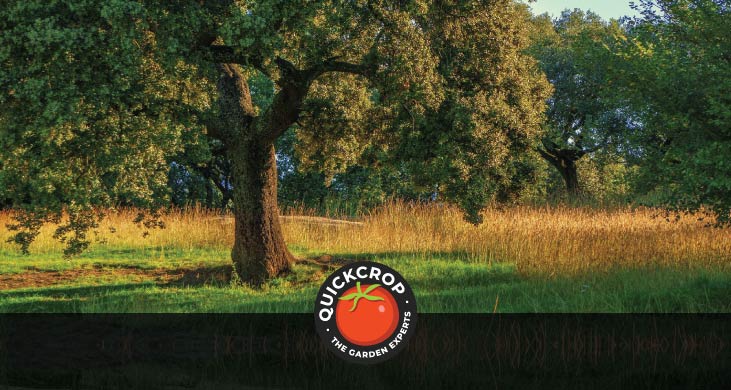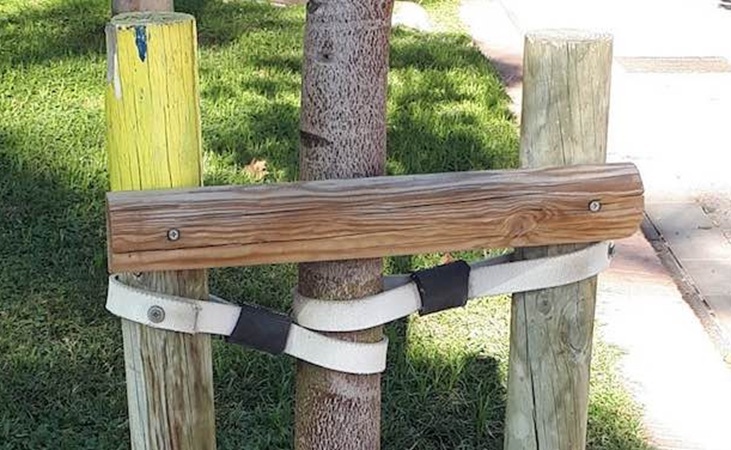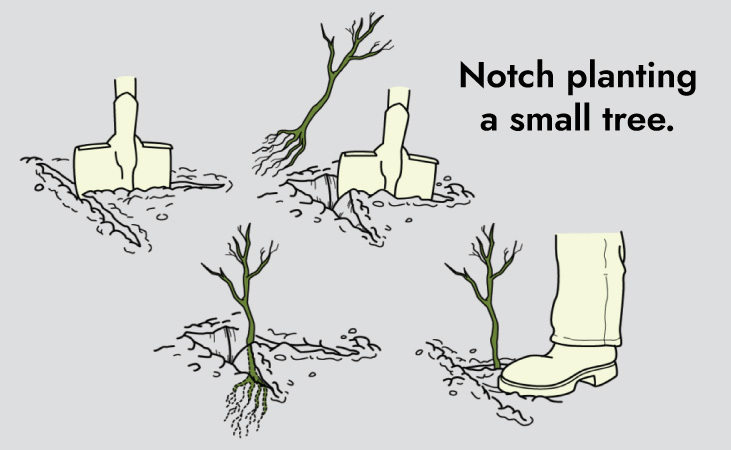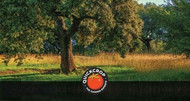How To Plant Bare Root Trees

Everyone seems to be talking about trees these days and with good reason. They are one of the single most effective ways to take carbon out of the atmosphere and help slow global warming. Trees also give us many other benefits including soil conservation, flood prevention and habitat creation.
In general trees are quite easy to plant (especially bare root trees), they don't require much maintenance and will be a growing asset for generations. Wherever there is available space we really should be planting more of them.

Some of the many benefits that trees provide include:
- improved air quality
- providing shade or a natural windbreak
- they are immensely beneficial as wildlife habitat
- natural beauty
- when well planned they can increase property value
- they can provide food both for us and for wildlife
As you probably know, most of Ireland was covered by trees following the last glaciation 10,000 years ago. It was said that Irish forests were so extensive that a squirrel could cross from one side of the country to the other without touching the ground (though how this was communicated so long ago - and by whom - remains a mystery).

Silver Birch - Betula Pendula - Bare Root Trees
View ProductSadly, after Millennia of human activity (which included Neolithic farmers, Bronze age metal workers, the Vikings, the Cistercians and the Normans), much of the country's ancient forests had been cleared. By the time the Tudors turned up, there were very few significant woods left.
This sorry state of affairs remains the case today, with Ireland being one of the least wooded countries in Europe. Recent statistics show that the country's forest cover is roughly 11%, and shockingly only 1% of our land area consists of naturally established native forest. (Flynn, Valerie. The Journal, 8 Oct. 2024, https://www.thejournal.ie/ireland-trees-forest-native-6504510-Oct2024/)

Such is the scale of the problem that Ireland was referred to as an 'ecological deadzone' in the pages of the Guardian; ecologists agree on the pressing need for more native trees, whether in woodlands, parks, urban areas, private land or in gardens.
The latter, of course, is where we come in. Provided we have the space, planting native trees is one of the best things that we can do for biodiversity and for a healthier ecosystem with better climate resilience.

Red Oak - Quercus Rubra, 1-3 Pack
View ProductOur Bare Root Tree Range
At Quickcrop we supply a range of bare root tree saplings, which are sent out in early November. We have chosen to supply smaller 60-90cm trees for a number of reasons, but I guess the main ones from your point of view is that they are more cost-effective but will also produce a much better tree.
We also offer a 'choose your own' pack of 6 native or specimen trees. We have set up the product page so that you can view up to 15 varieties and choose any mix of trees provided. There is also information about each tree, including height and spread which can be accessed by clicking on the 'About Plant' highlighted text.

'Bare Root': This means that the tree is sold and planted without soil around its roots. Bare root trees are typically dormant when sold; this makes them easier to transport, and more likely to establish well in the ground if planted correctly.
'Whip': This refers to a young, slender, unbranched (or very minimally branched) tree, usually 1-2 years old. Whips are typically 60 cm to 180 cm tall (depending on what nursery you buy from) with a straight, single stem. They haven’t developed a thick trunk or a large canopy yet.

Willow Salix alba - White Willow, 1-3 pack
View ProductTree Roots and Whips
One of the reasons trees often need to be staked when planted is that their canopy is out of balance with their root systems (in other words, they are top-heavy). Staking is almost inevitable with a large transplant, but is not necessary with trees below 120cm.
The problem with replanting larger trees is no matter how much of a root ball you bring with it you will have lost over 50% of the original root mass. Smaller transplants have a more balanced root/stem ratio, so will establish quicker and produce a healthier, more stable tree.

A whip also offers very little wind resistance and will bend rather than rock, so is less likely to pull on its roots. A tree needs an amount of movement when young, as this strengthens up the trunk and also gives it its taper. Trunk movement also stimulates root growth, so although staked trees might grow taller quicker than unstaked trees, their trunks will be weaker and their root systems less developed.
As you can see in the image above, tree roots don't mirror the shape of the canopy below ground, but spread out much further than the tree in a wide mat close to the surface. This makes sense as there is more air and nutrients in the top layers of soil. The surface roots form a fine web and are the feeding roots; while the deep tap roots below the tree are growing down in search of water.

Notch Planting
Notch planting is a very quick and easy method for planting bare root trees. To do so you create an opened out T-shaped slit to plant the tree in. This method is only suitable for whips (another advantage of planting small) but means you can get a large number of trees in the ground in an afternoon.
I also add a sprinkle of blood, fish and bone fertiliser in and around the planting hole to promote root growth. Blood, fish and bone is high in root-building phosphorous, so it's very good for planting bare root trees, hedging or fruit plants.

Westland Fish, Blood & Bone Meal
View ProductIn the image below, the circular area around the sapling has been cleared of any deep root weeds and covered with plenty of mulch to prevent any further weed seeds from germinating.
I also dug a shallow channel around the perimeter to keep the mulch in place and to be able to run the lawnmower over the edge. I have gone to all this trouble as a tree will establish much quicker without any weed competition.

Recommended Trees for Garden Planting
Alder
The Alder tree can suit many a garden; it's fast-growing and is tolerant of damp or poor soil conditions. Indeed it's often found in damp, boggy areas or growing along riverbanks (it's commonly seen along the banks of the Shannon).
The tree has glossy dark green leaves and (when mature) the bark takes on a grey-brown colour with distinctive fissures. The tree produces both male and female catkins in spring; the female ones later harden to form reddish brown cones which remain on the tree into winter.

The catkins are an early source of nectar and pollen (sometimes from February on), while the cone seeds are eaten by birds such as siskins and redpolls. The leaves act as a food plant for several moth species, while a mature alder tree can also host a variety of lichens, mosses and fungi.
Alder trees 'fix' nitrogen in the same way as legumes (peas and beans) by providing homes for nitrogen-fixing bacteria in nodules (pictured above) on their roots. While legumes partner with rhizobia for this job, non-legumes like Alder use the same method but a different group of bacteria from the genus 'Frankia'. A knock-on effect of all this is that the leaves can enrich the surrounding soil when they fall in Autumn.
Height: 15 - 25 m

Alder - Alnus glutinosa, 1-3 pack
View ProductRowan
The Rowan or Mountain Ash is a longer-lived pioneer tree (it can live up to 400 years). It is very hardy and can grow at high altitudes. It is also a very good garden tree, which can easily be kept at a manageable size without losing its shape.
Creamy white flowers provide a source of pollen and nectar in spring. Its clusters of bright red berries are a valuable food source from autumn to winter for birds such as the redstart, the song thrush and the redwing. The tree also supports various moth larvae. ("Sorbus aucuparia." Irish Tree Explorers Network https://www.ucc.ie/en/tree-explorers/trees/a-z/sorbusaucuparia/)

If you have apples the Rowan is a good companion tree, as birds will often eat the red fruit in preference to apples (which ripen around the same time).
It is probably also worth noting that the Mountain Ash (Sorbus) is not related to the common ash (Fraxinus), and so does not suffer from the ash die back disease that is killing so many European trees.
Height: 8 - 15 m

Rowan/Mountain Ash - Sorbus aucuparia, 1-3 Pack
View ProductHazel
Hazel (Corylus avellana) is a small, multi-stemmed tree or large shrub that’s perfect for garden edges; you can also grow Hazel as wildlife-friendly hedging.
Long yellow catkins appear in January through to March, as well as small red female flowers. Broad, slightly hairy green leaves turn golden yellow in autumn. Edible hazelnuts also appear in autumn, providing sustenance for red squirrels, jays or nuthatches. The hazel tree also supports hundreds of insect species, which in turn feed wildlife such as bats.

In woodlands this tree has traditionally been coppiced for sustainable wood, when done carefully this encourages biodiversity and provides shelter for ground-nesting birds. Coppicing results in long, straight, robust stems, which in the garden can be used to support beans and other climbing plants.
Hazel thrives in moist, well-drained soil in partial to full sunlight. It grows at a rate of about 40-60cm a year.
Height: 4 - 8 m

Hazel - Corylus avellana, 1-3 Pack
View ProductWild Cherry
The Wild Cherry tree (Prunus avium) is better suited to larger gardens, as the vigorously growing roots can spread and potentially even lift paving. If you have the space though, this is a very attractive ornamental tree.
Blossoms of fragrant white or pale pink flowers arrive in early spring, attracting bees and other pollinators. Oval shaped leaves with toothed edges serve as a food plant for various moth species, while cherry bark moth larvae feed under the surface of the tree’s reddish-brown bark.

Edible cherries appear in summer, ripening from late July. These fruits are happily devoured by birds, who then disperse the seeds. The cherries - although somewhat tart - can be used to make cherry brandy. Wild cherry wood meanwhile is often used in furniture-making.
In autumn the foliage takes on gorgeous hues of red, orange or yellow.

Wild cherry- Prunus avium, 1-3 Pack
View ProductWild Cherry prefers fertile, well-drained soil and a sunny position, although it will also do well in dappled shade. It requires minimal pruning when established.
Height: 20 - 30 m

Crab Apple
The Crab Apple (Malus sylvestris) is a small to medium-sized deciduous tree with an irregular, rounded shape and a compact habit. It produces clusters of pink-tinged white blossoms in spring, which are sweetly scented and nectar-rich.
Small, yellow-green apples - measuring 2-3cm across - appear on the tree from autumn into winter. It’s worth noting that these fruits are more bitter and acidic than the cultivated apples we are familiar with; they are however very good for making jam or crab apple jelly. The fruits are eaten by various bird species including fieldfares and song thrushes.

Crab Apple - Malus Sylvesteris, 1-3 Pack
View ProductThe tree’s glossy, oval-shaped leaves provide food for moth caterpillars such as the Pale Tussock or the Eyed Hawk Moth. The dense foliage can also be used as shelter, cover or nesting sites by robins, goldfinches and other birds.
Malus Sylvestris can tolerate most soil types, but it prefers a moist, well-drained site with either full sun or partial shade.
Height: up to 10 m




